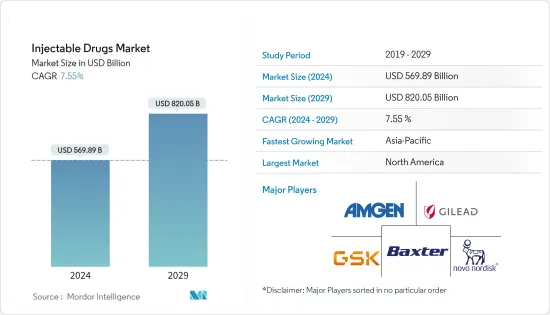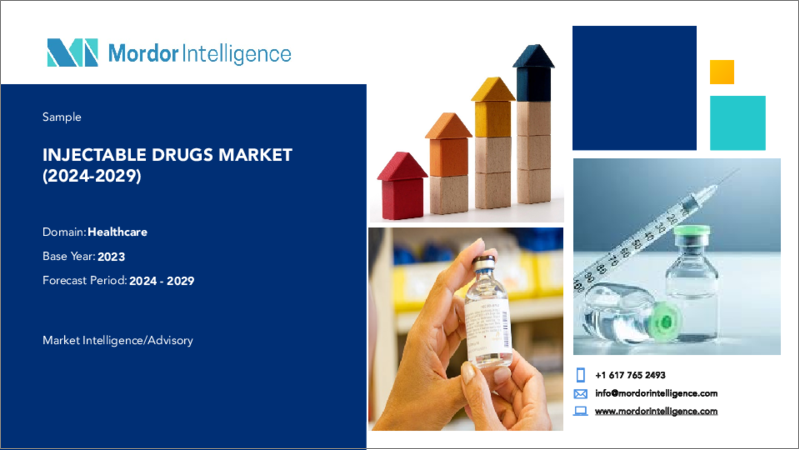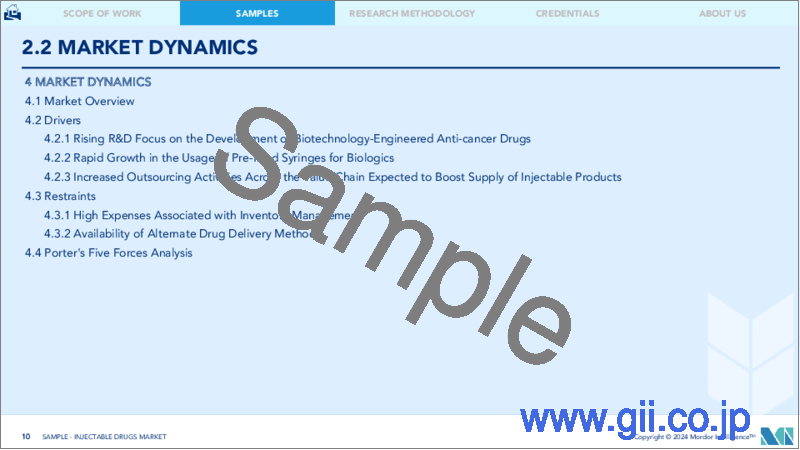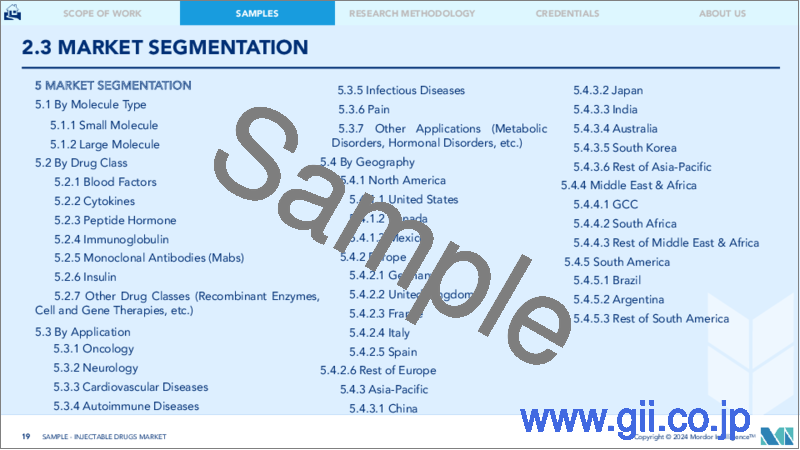|
|
市場調査レポート
商品コード
1437948
注射薬:市場シェア分析、業界動向と統計、成長予測(2024~2029年)Injectable Drugs - Market Share Analysis, Industry Trends & Statistics, Growth Forecasts (2024 - 2029) |
||||||
カスタマイズ可能
適宜更新あり
|
|||||||
| 注射薬:市場シェア分析、業界動向と統計、成長予測(2024~2029年) |
|
出版日: 2024年02月15日
発行: Mordor Intelligence
ページ情報: 英文 115 Pages
納期: 2~3営業日
|
全表示
- 概要
- 目次
注射薬市場規模は2024年に5,698億9,000万米ドルと推定され、2029年までに8,200億5,000万米ドルに達すると予測されており、予測期間(2024年から2029年)中に7.55%のCAGRで成長します。

新型COVID-19は、調査対象の市場の成長に影響を与えました。パンデミック中、企業は医薬品を開発し、新型コロナウイルス感染症(COVID-19)のワクチン開発のための協力と承認を求めていました。これらのワクチンは主に注射可能な形で投与され、市場の成長を牽引しました。たとえば、2020年5月、アストラゼネカは、オックスフォード大学のCOVID-19ワクチンの開発、生産、提供のために、米国保健省生物医学先端研究開発局(BARDA)から10億米ドル以上の資金提供を受けました。さらに、COVID-19症による制限が解除され、企業活動が再開されたことにより、市場は予測期間中に成長すると予想されます。
バイオテクノロジー工学による抗がん剤の開発に焦点を当てた研究開発の増加、生物製剤用のプレフィルドシリンジの使用の急速な増加、注射剤の供給増加が期待されるバリューチェーン全体にわたるアウトソーシング活動の増加などの要因が市場を押し上げています。
がん、糖尿病、心血管疾患などの慢性疾患の有病率の上昇が、市場の成長を推進する重要な要因です。たとえば、2022年 5月にBioMed Central Journalに掲載された記事によると、インドでは2,670万人ががんに苦しんでおり、この数は2025年までに2,980万人に増加すると予測されています。 IDFによると、フランスでは約390万人が糖尿病を抱えており、この数は2030年までに410万人、2045年までに420万人に達すると予測されています。したがって、人口の慢性疾患の負担が大きいため、糖尿病を効果的に治療する需要が高まることが予想されます。安全な注射薬が市場の成長を促進します。
さらに、英国保健安全庁が2021年12月に発表した報告書では、2020年には英国で推定97,740人がHIVとともに暮らしており、2020年の推定4,660人は感染に気づいていないと述べており、これは注射可能なHIV薬と予測期間中に市場の成長を促進すると予想される製剤。また、2021年8月に国際ジャーナル・フォー・エクイティ・イン・ヘルスに掲載された論文によると、60歳以上の高齢者人口の75.8%が、心臓病、がん、慢性肺などの1つ以上の慢性疾患に悩まされていることが観察されました。病気、その他。
さらに、新しい治療クラス向けの注射薬の開発に対する企業の注目の高まりにより、医師や患者による注射薬の採用と市場での入手可能性が増加すると予想され、それが市場の成長を促進すると予想されます。たとえば、2022年9月にUSFDAは生物製剤ライセンス申請(BLA)を受理し、アルファマンノシドーシスの治療のための酵素補充療法であるChiesi世界希少疾患のベルマナーゼアルファに優先審査指定を与えました。また、2021年12月に米国食品医薬品局は、性行為によるHIV感染のリスクを軽減するための暴露前予防として、体重35kg以上の青少年を対象としたアプレチュード(カボテグラビル徐放性注射用懸濁液)を承認しました。
さらに、バイオエンジニアリング抗がん剤の開発の高まりも市場の成長を加速させています。たとえば、2022年4月、中国国家医療製品総局(NMPA)は、食道がんの一種である局所進行性または転移性食道扁平上皮がん(ESCC)患者の治療にベイジーンのティスレリズマブを承認しました。また、2021年12月、中国国家医薬品監督管理局(NMPA)の医薬品評価センター(CDE)は、エノブリツズマブ(別名TJ271)とエノブリツズマブ(TJ271としても知られる)の中国での第2相試験開始に向けたI-MabのIND申請を承認しました。非小細胞肺がん(NSCLC)、尿路上皮がん(UC)、およびその他の選択されたがんを含む固形腫瘍患者におけるペムブロリズマブ(キイトルーダ)。
ただし、在庫管理に関連する高額な費用と代替ドラッグデリバリーメタンの利用可能性は、予測期間中の市場の成長を妨げる可能性があります。
注射剤市場動向
腫瘍学は予測期間中にかなりの市場シェアを獲得すると予想される
腫瘍学分野では、人口におけるがん罹患率の上昇や生物工学的手法を使用した先進的な抗がん剤の開発などの要因により、予測期間中に注射薬市場が大幅に成長すると予想されています。たとえば、Globocan 2020によると、中国は2020年に4,568,754人の新たながん症例を報告し、5年間で9,294,006人のがん症例が蔓延したと報告しています。さらに、同報告書は、がん症例数が2030年までに5,811,629人、2040年までに6,845,787人に達すると予測しています。同様に、同じ情報源によると、日本は2020年に新たながん症例数が1,028,658人で、5年間に蔓延したがん症例の総数は2,710,728人となった。同報告書は、がん症例数が2030年までに1,110,549人、2040年までに1,128,057人に達すると予測しています。したがって、人口全体のがん症例数の予想増加により、注射用抗がん剤の需要が促進されると予測されています。市場の成長を促進すると予想されます。
さらに、企業活動の活発化と製品発売の増加もこの部門の成長に貢献しています。たとえば、食品医薬品局は2022年11月に、転移性非小細胞肺がん(NSCLC)の成人患者を対象に、トレメリムマブとデュルバルマブおよびプラチナベースの化学療法の併用を承認しました。また、2022年5月にグランド・ファーマは、多発性骨髄腫やマントル細胞リンパ腫などの特定の種類のがんの治療に使用されるボルテゾミブ注射剤を米国で発売しました。
したがって、がんの負担の増加と新製品の発売が、予測期間中の市場の成長を促進すると予想されます。
北米は注射薬市場で最大の市場シェアを保持
北米は、がん、糖尿病、心血管疾患などの慢性疾患の罹患率の高さ、強固なヘルスケアインフラ、この地域の主要企業により、予測期間にわたって注射薬市場を独占すると予想されています。
さらに、新製品の発売数の増加、研究開発への巨額投資、さまざまな種類のがんを治療するための病院での注射薬の採用の増加も、この地域の市場の成長に貢献しています。
米国がん協会の2022年報告書によると、2022年には米国で190万人を超える新たながん症例が記録されると予想されています。また、同じ情報源によると、がんのリスクは年齢とともに劇的に増加します。米国では、がん患者の80%が55歳以上で、そのうち57%が65歳以上です。したがって、高齢者人口の増加は、調査対象の市場に大きな影響を与えると予想されます。さらに、国際糖尿病連盟の2021年 12月の報告書によると、米国では約3,220万人が糖尿病を抱えて暮らしています。この数は、2045年までに3,630万人に増加すると推定されています。この糖尿病患者数の増加により、注射剤の需要が高まり、市場の成長が促進されると予想されます。
慢性疾患の効果的な治療薬に対する需要が高まる中、製品の発売、合併・買収、パートナーシップ、戦略的提携などの企業活動が、この国で調査されている市場の成長を促進すると予想されています。たとえば、2022年5月にロシュは、乳がん治療薬としてパージェタ(ペルツズマブ)とハーセプチン(トラスツズマブ)とヒアルロニダーゼを組み合わせたPHESGOを発売しました。また、2022年2月、米国食品医薬品局(FDA)は、12年間の成人および小児患者における遺伝性血管浮腫(HAE)の発作を予防するために、武田薬品のTAKHZYRO(ラナデルマブ-フライオ)注射用単回用量プレフィルドシリンジ(PFS)を承認しました。年齢以上。
したがって、上記の要因により、注射剤市場は予測期間中にこの地域で成長すると予想されます。
注射薬業界の概要
注射薬市場の競争は中程度です。主要な市場プレーヤーには、GlaxoSmithKline PLC、Baxter International Inc.、Amgen Inc.が含まれます。市場の主要企業の中には、製造と流通を容易にする特定の製品に関して統合パートナーシップを結んでいる企業もあります。さまざまな企業が生産能力を拡大して拡大することも、市場全体の押し上げに役立ちます。
その他の特典
- エクセル形式の市場予測(ME)シート
- 3か月のアナリストサポート
目次
第1章 イントロダクション
- 調査の前提条件と市場の定義
- 調査範囲
第2章 調査手法
第3章 エグゼクティブサマリー
第4章 市場力学
- 市場概要
- 市場促進要因
- バイオテクノロジー工学による抗がん剤の開発に向けた研究開発の注目の高まり
- 生物製剤用プレフィルドシリンジの使用が急速に拡大
- バリューチェーン全体にわたるアウトソーシング活動の増加による注射用製品の供給の増加
- 市場抑制要因
- 在庫管理に伴う高額な費用
- 代替ドラッグデリバリー方法の利用可能性
- ポーターのファイブフォース分析
- 新規参入業者の脅威
- 買い手の交渉力
- 供給企業の交渉力
- 代替製品の脅威
- 競争企業間の敵対関係の激しさ
第5章 市場セグメンテーション
- 分子の種類別
- 低分子
- 高分子
- 薬剤クラス別
- 血液因子
- サイトカイン
- ペプチドホルモン
- 免疫グロブリン
- モノクローナル抗体(mAb)
- インスリン
- 他の薬物クラス
- 用途別
- 腫瘍学
- 神経内科
- 心血管疾患
- 自己免疫疾患
- 感染症
- 痛み
- その他の用途
- 地域別
- 北米
- 米国
- カナダ
- メキシコ
- 欧州
- ドイツ
- 英国
- フランス
- イタリア
- スペイン
- その他欧州
- アジア太平洋
- 中国
- 日本
- インド
- オーストラリア
- 韓国
- その他アジア太平洋地域
- 中東とアフリカ
- GCC
- 南アフリカ
- その他中東およびアフリカ
- 南米
- ブラジル
- アルゼンチン
- その他南米
- 北米
第6章 競合情勢
- 企業プロファイル
- Novo Nordisk AS
- Amgen Inc.
- Baxter International Inc.
- Gilead Sciences Inc.
- GlaxoSmithKline PLC
- Johnson &Johnson
- Merck &Co. Inc.
- Novartis AG
- Pfizer Inc.
- Sanofi SA
- AbbVie
- F. Hoffmann-La Roche Ltd
第7章 市場機会と将来の動向
The Injectable Drugs Market size is estimated at USD 569.89 billion in 2024, and is expected to reach USD 820.05 billion by 2029, growing at a CAGR of 7.55% during the forecast period (2024-2029).

COVID-19 impacted the growth of the market studied. During the pandemic, companies were developing drugs and seeking collaborations and approvals to develop a vaccine for COVID-19. These vaccines were majorly given in the injectable form, driving the market growth. For instance, in May 2020, AstraZeneca received more than USD 1 billion in funding from the US Health Department's Biomedical Advanced Research and Development Authority (BARDA) for the development, production, and delivery of the University of Oxford's COVID-19 vaccine. Moreover, with the released COVID-19 restrictions and resumed company activities, the market is expected to grow over the forecast period.
The factors such as rising R&D focus on developing biotechnology-engineered anti-cancer drugs, rapid growth in the usage of pre-filled syringes for biologics, and increased outsourcing activities across the value chains expected to raise the supply of injectable drugs are boosting the market growth.
The rising prevalence of chronic diseases such as cancer, diabetes, cardiovascular diseases, and others is the key factor driving the market growth. For instance, from an article published in BioMed Central Journal in May 2022, it has been observed that 26.7 million people in India were suffering from cancer and this number is projected to increase to 29.8 million by 2025. Also, according to 2022 statistics published by the IDF, about 3.9 million people were living with diabetes in France, and this number is projected to reach 4.1 million by 2030 and 4.2 million by 2045. Thus, the high burden of chronic diseases among the population is anticipated to increase the demand for effective and safe injectable drugs hence propelling the market growth.
Additionally, a report published by the UK Health Security Agency in December 2021, stated that in 2020, an estimated 97,740 people were living with HIV in England and an estimated 4,660 in 2020 were unaware of their infection, indicating the demand for injectable HIV drugs and formulations, which are anticipated to augment the market growth over the forecast period. Also, from an article published in the International Journal for Equity in Health in August 2021, it was observed that 75.8% of the elderly population aged 60 years and above were troubled by one or more chronic diseases such as heart disease, cancer, chronic lung diseases, and others.
Furthermore, the rising focus of companies on developing injectable drugs for new therapeutic classes is expected to increase their adoption by physicians and patients and their availability in the market, which in turn is anticipated to fuel market growth. For instance, in September 2022, the USFDA accepted the Biologics License Application (BLA) and granted Priority Review designation to Chiesi Global Rare Diseases, velmanase alfa, an enzyme replacement therapy, for the treatment of alpha-mannosidosis. Also, in December 2021, the USFDA approved Apretude (Cabotegravir extended-release injectable suspension) for adolescents weighing at least 35 kg for pre-exposure prophylaxis to reduce the risk of sexually acquired HIV.
Moreover, the rising development of bio-engineered anti-cancer drugs is also increasing the market growth. For instance, in April 2022, the China National Medical Products Administration (NMPA) approved BeiGene's tislelizumab to treat patients with locally advanced or metastatic oesophageal squamous cell carcinoma (ESCC), a type of oesophageal cancer. Also, in December 2021, the Center for Drug Evaluation (CDE) of China's National Medical Products Administration (NMPA) approved I-Mab's IND submission for the initiation of a phase 2 trial in China for enoblituzumab (also known as TJ271) in combination with pembrolizumab (Keytruda) in patients with solid tumors, including non-small cell lung cancer (NSCLC), urothelial carcinoma (UC), and other selected cancers.
However, the high expenses associated with inventory management and the availability of alternate drug delivery methanes are likely to hinder the market growth over the forecast period.
Injectable Drugs Market Trends
Oncology Is Expected to Have Significant Market Share During the Forecast Period
The oncology segment is expected to witness significant growth in the injectable drugs market over the forecast period, owing to factors such as the rising prevalence of cancer among the population and the development of advanced cancer drugs using bio-engineered methods. For instance, according to Globocan 2020, China reported 4,568,754 new cancer cases in 2020, and 9,294,006 cancer cases were prevalent for five years. Further, the same report projected that cancer cases will reach 5,811,629 by 2030 and 6,845,787 by 2040. Similarly, as per the same source, Japan reported 1,028,658 new cancer cases in 2020, and the total number of five-year prevalent cancer cases was 2,710,728. The same report projected the number of cancer cases to reach 1,110,549 by 2030 and 1,128,057 by 2040. Thus, the expected rise in the number of cancer cases among the population is projected to propel the demand for injectable cancer drugs, which, in turn, is anticipated to fuel market growth.
Furthermore, the rise in company activities and increasing product launches are also contributing to this segment's growth. For instance, in November 2022, the Food and Drug Administration approved tremelimumab in combination with durvalumab and platinum-based chemotherapy for adult patients with metastatic non-small cell lung cancer (NSCLC). Also, in May 2022, Gland Pharma launched Bortezomib injection, which is used to treat certain types of cancer, such as multiple myeloma and mantle cell lymphoma, in the United States.
Thus, the increasing burden of cancer and the launch of novel products are expected to drive the market's growth over the forecast period.
North America Holds the Largest Market Share of the Injectable Drugs Market
North America is expected to dominate the injectable drugs market over the forecast period owing to the high prevalence of chronic diseases such as cancer, diabetes, and cardiovascular diseases, robust healthcare infrastructure, and major players in the region.
In addition, the increasing number of novel product launches, huge investments in R&D, and the increased adoption of injectable drugs in hospitals to treat different types of cancer are also contributing to the market growth in the region.
According to the American Cancer Society's 2022 report, over 1.9 million new cancer cases are expected to be recorded in the United States in 2022. Also, per the same source, cancer risk rises dramatically as one ages. In the United States, 80% of cancer patients are 55 years or older, with 57% being 65 years or older. Thus, the growing geriatric population is expected to impact the market studied significantly. Further, according to the International Diabetes Federation's report of December 2021, about 32.2 million people were living with diabetes in the United States. This number is estimated to increase to 36.3 million by 2045. This increase in the diabetes patient pool is expected to drive demand for injectable drugs, which will boost growth in the market.
With the growing demand for effective therapeutics for chronic diseases, company activities such as product launches, mergers and acquisitions, partnerships, and strategic collaborations are expected to augment growth in the market studied in the country. For instance, in May 2022, Roche launched PHESGO, a combination of Perjeta (pertuzumab) and Herceptin (trastuzumab) with hyaluronidase to treat breast cancer. Also, in February 2022, the United States Food and Drug Administration (FDA) approved Takeda's TAKHZYRO (lanadelumab-flyo) injection single-dose prefilled syringe (PFS) to prevent attacks of hereditary angioedema (HAE) in adult and pediatric patients 12 years of age and older.
Therefore, due to the factors mentioned above, the injectable drugs market is expected to grow in the region over the forecast period.
Injectable Drugs Industry Overview
The injectables drugs market is moderately competitive. The key market players include GlaxoSmithKline PLC, Baxter International Inc., and Amgen Inc. Some of the major players in the market have consolidated partnerships for certain products that allow for ease of manufacturing and distribution. The expansion of different companies to increase their production capacities also helps boost the overall market.
Additional Benefits:
- The market estimate (ME) sheet in Excel format
- 3 months of analyst support
TABLE OF CONTENTS
1 INTRODUCTION
- 1.1 Study Assumptions and Market Definition
- 1.2 Scope of the Study
2 RESEARCH METHODOLOGY
3 EXECUTIVE SUMMARY
4 MARKET DYNAMICS
- 4.1 Market Overview
- 4.2 Market Drivers
- 4.2.1 Rising R&D Focus on the Development of Biotechnology-engineered Anti-cancer Drugs
- 4.2.2 Rapid Growth in the Usage of Pre-filled Syringes for Biologics
- 4.2.3 Increased Outsourcing Activities Across Value Chain Expected to Boost Supply of Injectable Products
- 4.3 Market Restraints
- 4.3.1 High Expenses Associated with Inventory Management
- 4.3.2 Availability of Alternate Drug Delivery Methods
- 4.4 Porter's Five Forces Analysis
- 4.4.1 Threat of New Entrants
- 4.4.2 Bargaining Power of Buyers/Consumers
- 4.4.3 Bargaining Power of Suppliers
- 4.4.4 Threat of Substitute Products
- 4.4.5 Intensity of Competitive Rivalry
5 MARKET SEGMENTATION (Market Size by Value - USD million)
- 5.1 By Molecule Type
- 5.1.1 Small Molecule
- 5.1.2 Large Molecule
- 5.2 By Drug Class
- 5.2.1 Blood Factors
- 5.2.2 Cytokines
- 5.2.3 Peptide Hormone
- 5.2.4 Immunoglobulin
- 5.2.5 Monoclonal Antibodies (mAbs)
- 5.2.6 Insulin
- 5.2.7 Other Drug Classes
- 5.3 By Application
- 5.3.1 Oncology
- 5.3.2 Neurology
- 5.3.3 Cardiovascular Diseases
- 5.3.4 Autoimmune Diseases
- 5.3.5 Infectious Diseases
- 5.3.6 Pain
- 5.3.7 Other Applications
- 5.4 By Geography
- 5.4.1 North America
- 5.4.1.1 United States
- 5.4.1.2 Canada
- 5.4.1.3 Mexico
- 5.4.2 Europe
- 5.4.2.1 Germany
- 5.4.2.2 United Kingdom
- 5.4.2.3 France
- 5.4.2.4 Italy
- 5.4.2.5 Spain
- 5.4.2.6 Rest of Europe
- 5.4.3 Asia-Pacific
- 5.4.3.1 China
- 5.4.3.2 Japan
- 5.4.3.3 India
- 5.4.3.4 Australia
- 5.4.3.5 South Korea
- 5.4.3.6 Rest of Asia-Pacific
- 5.4.4 Middle East and Africa
- 5.4.4.1 GCC
- 5.4.4.2 South Africa
- 5.4.4.3 Rest of Middle East and Africa
- 5.4.5 South America
- 5.4.5.1 Brazil
- 5.4.5.2 Argentina
- 5.4.5.3 Rest of South America
- 5.4.1 North America
6 COMPETITIVE LANDSCAPE
- 6.1 Company Profiles
- 6.1.1 Novo Nordisk AS
- 6.1.2 Amgen Inc.
- 6.1.3 Baxter International Inc.
- 6.1.4 Gilead Sciences Inc.
- 6.1.5 GlaxoSmithKline PLC
- 6.1.6 Johnson & Johnson
- 6.1.7 Merck & Co. Inc.
- 6.1.8 Novartis AG
- 6.1.9 Pfizer Inc.
- 6.1.10 Sanofi SA
- 6.1.11 AbbVie
- 6.1.12 F. Hoffmann-La Roche Ltd





